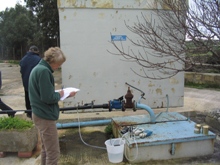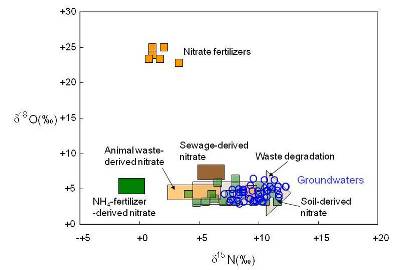Nitrate sources in Malta
The two main Maltese islands, Malta and Gozo, have had a problem with elevated groundwater nitrate. The BGS carried out a study for the Maltese government to try to identify the most important sources of nitrate to enable them to bring in effective controls on key activities, and in the longer term to reduce groundwater nitrate to acceptable levels. The high population and livestock density on Malta, combined with limited land availability and low groundwater recharge, mean that this is challenging. A scheme to upgrade manure stores had already been implemented.
Setting
The Maltese islands are mainly composed of limestones. There are two aquifers separated by a low permeability layer (comprising the Blue Clay and the Globigerina Limestone). The Upper Coralline Limestone forms the upper aquifer which sits up to 100 m above sea level and is fragmented and thin. The Lower Coralline Limestone forms the deeper aquifer, where groundwater levels are depressed to near sea level by abstraction from boreholes and galleries.
Nitrate sources
Potential sources of nitrate in groundwater include:
- cultivated soils
- leaking sewers and cesspits
- manure stores and illicit pig slurry disposal
- reuse of treated sewage effluent for irrigation
- synthetic and organic fertilisers
Techniques

A range of indicators were used to help us to relate nitrate to landuse activities. These included:
- nitrate stable isotopes — δ15N and δ18O are invaluable tools for understanding the origin and evolution of nitrate
- dissolved organic carbon and fluorescence — these are indicators of organic material inputs, such as manure or sewage
- residence time indicators — CFCs and SF6 can be used to show how long it has taken for groundwater to travel through the saturated zone
- coliform bacteria — these have a limited lifetime in the subsurface so detecting coliforms indicates a fast pathway from their source.
Groundwater samples were collected from large pumping stations and individual boreholes, and also from springs on the margins of the perched upper aquifers. We also collected samples of potential source terms and cultivated soils.
Main findings
The nitrate in the groundwater samples we collected was most likely to be derived from cultivated soils and also from manure, but probably not from synthetic fertilisers or sewage. Stable isotope results (see Figure 3) suggest that only soil-derived nitrate and matured animal wastes have a similar isotopic composition to the nitrate in Maltese groundwater.
There was little evidence of denitrification so the generally lower concentrations observed in samples from Gozo must be due to the protection of the groundwater by the extensive low permeability Blue Clay capping.
Relatively low counts of coliform bacteria suggested that there are not widespread rapid pathways from the surface to the aquifer. Infiltration is predominantly via relatively slow flow through the aquifer matrix.
Long travel times in the unsaturated zone and slow saturated zone movement mean that changes to agricultural practices may not be reflected in the groundwater nitrate concentrations for some time.
Publications
This work was reported in:
Heaton, T H E, Stuart, M E, Sapiano, M, and Micallef Sultana, M. 2012. An isotope study of the sources of nitrate in Malta's groundwater. Journal of Hydrology, Vols. 414–415, 244–254.
Stuart, M E, Maurice, L, Heaton, T H E, Sapiano, M, Micallef Sultana, M, Gooddy, D C, and Chilton, P J. 2010. Groundwater residence time and movement in the Maltese islands – A geochemical approach. Applied Geochemistry, 25, 609–620.
Stuart, M E. 2009 Going underground. Planet Earth (Summer), 18–19.
Stuart, M E, Sapiano, M, Maurice, L, Gooddy, D C, and Chilton, P J. 2010. Groundwater residence time in Malta. In: Island and Coastal Hydrogeology, London, UK, 9 Dec 2010.
Heaton, T H E, Stuart, M E, Sapiano, M, and Micallef Sultana, M. 2010 Isotope tracing of nitrate: lessons from Malta. In: SIMSUG 2010, Exeter, UK, 28–30 April 2010.
Contact
Contact Pauline Smedley for further information








